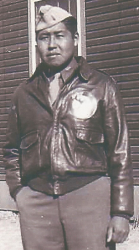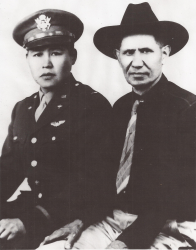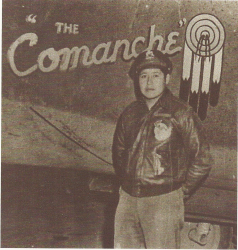
 |
|
|
||
|
Myers Wahnee, Sr. |
||||
|
Engagements: • World War II (1941 - 1945)• Korean War (1950 - 1953) |
||||
| Biography: | ||||
|
Myers Wahnee, Sr. Myers Wahnee was born on 2 December 1918, the son of Tah-do-quad Shannon and Hebo Blanche Seahmer Toahnipper Wahnee. He was raised in the Fletcher, OK, area. He had 5 brothers, Ralph (a World War II Comanche Code Talker), Tom, Joe, Jasper and William Wahnee and 2 sisters, Margaret Thomas and Bertha Monatachi. He lost his mother when he was about 2 years old and was raised by his father and grandfather, Bert Tree Top Seahmer, in Walters and spent time with his many aunts and uncles. He attended high schools in Apache, Fort Sill Indian School, Roe Institute, Wichita North High, KS, and Haskell Institute. While in high school he lettered in football and wrestling and was the Kansas Verdigris Valley State Wrestling Champion. After graduating from high school, he attended college at Friends University (in Wichita, KS) and Cameron Junior College. Military Service On 28 September 1941, Wahnee enlisted in the U.S. Army Air Corps at Lawton, OK. He took his Basic and Primary training at Valdosta, GA, and Lemoore, CA. Wahnee was then selected for pilot training and sent to Williams Field in Chandler, AZ, where he received his Pilot Wings in April 1942 with the first graduating class at Williams Field. From there he was sent to Columbus, MS, for advanced training on twin engine aircraft. His next assignment was at Moody Field in Valdosta, GA, where he trained Pilot Cadets of the Royal Air Force on twin engine aircraft – he was 1 of 10 Instructors to fly the new B-26 bomber. In July 1943, he was assigned to the then new B-24 Liberator, a 4-engine bomber, at McDill Field, FL. Additional training was conducted near Fort Worth, TX, and then on to Gowen Field outside of Boise, ID, to meet his second crew. Wahnee trained his second crew at Sioux City Army Air Base, IA. On 5 November 1943, Capt Wahnee and his second crew * flew from West Palm Beach FL, via the southern route (Brazil, Portugal or North Africa) to England. He was based at Seething Air Field, Norwich, England, with Crew 56, 714th Bomb Squadron, 2nd Air Division, 448th Bomber Group (Heavy), 8th Air Force. * Capt Wahnee’s first crew was “lost at sea” in the Atlantic Ocean between Brazil and Europe. Before they departed on that fateful flight, Capt Wahnee developed an ear infection and was forbidden to fly. His crew departed with another pilot. The aircraft and crew have never been recovered. Wahnee’s first mission was in December 1943 – in all he logged 300+ combat hours and 33 missions. His co-pilot, Stuart Barr, said the following about the fateful day The Comanche was shot down: “On 20 March 1944, the crew of The Comanche was on standby in the event one of the aircraft scheduled to fly that day had to abort their mission – it happened. With 12 five-hundred pound bombs aboard, the war-weary Comanche took to the skies and caught up with the formation and filled the empty slot. Flying at 23,000 feet, the ground was clearly visible and the weather unusually clear. The mission was suddenly aborted, so on that day Frankfurt, Germany, was spared eighty-four tons of high explosives. The return to England was interrupted by anti-aircraft fire over northern France. The Comanche was severely hit by 155mm flak at the root of the right wing causing severe fuel loss and oscillation of the controls, crippling her to stay aloft. To gain control, the bombs and other ordinance were released. Capt Wahnee ordered his crew to bail out while he and I remained with The Comanche. Covered with 135-grade fuel, Capt Wahnee remained in the cockpit and ordered me to bail out. Just prior to jumping, I looked and saw Capt Wahnee unbuckle his seat belt. Unable to gain control of The Comanche, he finally decided to abandon his aircraft and bailed out over France. He was carried over the English Channel until a wind caught his parachute and blew him back toward Belgium. Capt Wahnee, already wounded by flak while aboard The Comanche, injured his feet and legs upon landing. He was immediately surrounded and captured by the German SS who, despite his injuries, beat him severely. Our trails didn’t cross until 1951 in Roswell, NM. He took me to his home in Mountain View, OK, where I met his wonderful wife Maggie. He named one of his sons after me, Stuart Barr Wahnee. I often think of him and will always be proud to have known him.” Capt Wahnee told family members after the war “that he always carried a medicine bundle – but on his last mission he couldn’t find it and flew without it.” Interesting Note So what happened to the B-24 Liberator named “The Comanche?” This is the story that SGM Lanny G. Asepermy was told, by Blanche Wahnee, about the whereabouts of “The Comanche." The bomber did not crash like you would imagine when it went down. It came down in a glide and slid to a stop about 100 yards from a school somewhere in either France or Belgium. The villagers in the town where the school is said the plane just landed. The German SS surrounded the plane and upon entering found no one there. Capt Wahnee said he knew about this and “The Comanche” landed and did not crash because he was such a good pilot. According to Blanche, a man in France is searching for the “The Comanche” and has yet to find it. After his capture, he was moved by land and rail to Stalag Luft 3, also called Stammlager Luft, which was located near the city of Sagan, Poland. This was the interrogation center where allied airmen were delivered. On 27 January 1945, with Soviet troops 16 miles from the camp, Capt Wahnee and 11,000 other prisoners were forced to march 34 miles in below-freezing weather and 6 inches of snow to Bad Muskau, Germany, where they rested for 30 hours and then onto Spremberg, Germany. Most likely, Capt Wahnee was moved, by train, to Stalag XIIID at Numberg and finally to Stalag VII A near the city of Moosburg in southern Bavaria, where he was liberated on 29 April 1945 by elements of the 14th Armored Division. When Capt Wahnee returned to the United States, he was very ill from starvation and the terrible treatment suffered while imprisoned. He was hospitalized on and off for several years and lived the remainder of his life with illnesses and injuries suffered from combat, and as a Prisoner of War. Despite physical aliments, Capt Wahnee remained in the Air Force and was stationed in Korea, but little is known about his service there. Both Myers Jr., and his daughter, Blanche, said he was a quiet reserved person who seldom talked about his military service. Medals, Awards & Badges Purple Heart Honors On 6 June 1984 (the 40th anniversary of the D-Day landing at Normandy, France) a memorial was dedicated in honor of the 448th Bombardment Group at Seething Air Field, England. A B-24 Liberator aircraft is pictured on each of the memorial's four corners and The Comanche is the aircraft located on the right lower corner. Post-Military Life After his military service, he graduated from Carnegie Junior College and, in 1954, graduated from Oklahoma A&M (now Oklahoma State University) with a degree in Agricultural Engineering. He was employed by the Bureau of Indian Affairs as an Agricultural Engineer. His son, Myers Jr, said his father was a “Gentleman Farmer” who raised wheat on a farm between Mountain View and Gotebo. Family Capt Wahnee married the former Maggie Tahome-Poolant and they had 7 children; Myers Jr.; Blanche; Joy; Ernest; and Stuart Wahnee and Dr. Wanda Priddy and Maude Washa.Death and Burial Captain Myers Wahnee, Sr. died on 4 July 1982. He is buried at Little Washita Indian Cemetery in Comanche County, OK. His daughter, Blanche, said that during his funeral at Little Washita Cemetery he was afforded a Color/Honor Guard, a firing squad, a Missing Man fly-by and a fly-over of B-24 Liberators – a fitting final tribute for this “Lord of the Sky.” Comments by his Crew Perhaps two of his crew members best summed-up what an outstanding leader and person Capt Myers Wahnee was. His Radio Operator, Lawrence Reep, said, “By the decisions Myers made at the time in battle the lives of his crew were saved. Myers Wahnee was one of the most loyal Americans and best pilots I ever flew with in combat or elsewhere. He saved my life.” His Flight Engineer, Walter Farmer said, “Because of his nationality or in spite of it, Myers was an exceptional patriotic American highly respected and well loved. Myers Wahnee was indeed a Great American. I was privileged to serve on his crew.” This Honoree Record was prepared with the valuable assistance of Lanny G. Asepermy, Sergeant Major, U.S. Army (Ret.) [Honoree Record ID 227117], Historian for the Comanche Indian Veterans Association in Lawton, OK. Photos are courtesy of SMG Asepermy. |
||||
| Honoree ID: 227322 | Created by: MHOH | |||
Ribbons
Medals
Badges
Honoree Photos
 |  |  |
 |  |
 |


